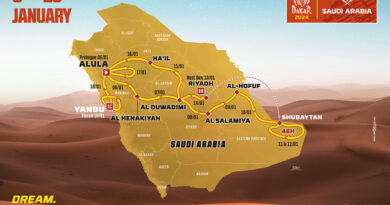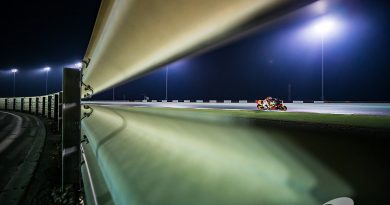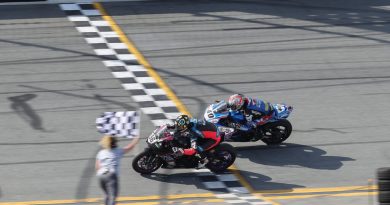21 In ’21: Wayne Rainey, Never Give Up
The following is the fourth in our 21 in ’21 features that highlight one of the 21 AMA Superbike Champions each week as we move through the 2021 MotoAmerica season – the 45th year of the premier class championship.
The 1983 AMA Superbike Championship wasn’t one that Wayne Rainey was supposed to win. With Honda bringing its brand-spanking-new VF750F to the party, the Superbike landscape changed. The Honda was good, really good, and Rainey and Kawasaki were suddenly in a whole world of trouble. Before they knew what hit ‘em, Hondas had won the first six races and the future looked pretty bleak.
Right up until the point when it wasn’t.
Rainey and his crew dug deep, persevered and never gave up. The championship came down to the final race of the year at Willow Springs Raceway in the high desert of Southern California, the site of Rainey’s first-ever road race. He wasn’t going down without a fight and fight he did, to the very end. With Rainey hounding him relentlessly and throwing non-stop body blows, Mike Baldwin and his mighty Honda buckled and crashed out of race one. Suddenly, Rainey and Kawasaki were back in the hunt and they took full advantage, winning both races at Willow that day and the championship.
Rainey learned a lot in 1983. He learned to never give up even when faced with the Mt. Everest of adversity, and it served him well for the rest of his career – a career in which he earned two AMA Superbike Championships and three 500cc World Championships – and his life after racing.
But let’s backtrack to 1983 and that first title.
“In ’82, I was riding the big 1000cc bikes,” Rainey recalls. “Then, in 1983, AMA changed the rule down to 750cc. So, Eddie (Lawson) was my teammate in ’82 but then he went off to go race in GPs. Kawasaki brought in Wes Cooley as my teammate. I think at that time the chassis development… the manufacturers started focusing on that. They started focusing a bit more on how the bike looked. We started having the front fairings on the bikes. So, the cosmetics, they started looking like proper racebikes instead of just an old street bike, like they did in ’82. So, it was an incredible time. Even though we had less ccs, with the new chassis and the way that the bikes worked, and tire development was starting to take off then. It was a real challenge in 1983. It was wicked.”
And then there was that damn Honda.
“I think the thing I remember most is when Honda brought out their new VFR. It was a four-valve, water-cooled V-four and Kawasaki just had a two-valve, inline air-cooled. So, we had our work cut out for us.”
Back then, a lot of the real work took place off the racetrack with mechanics and engineers literally reinventing the wheel as the season wore on.
“There was no computerization back then,” Rainey said. “There was no data whatsoever. It was basically what the rider could feel, and then he would relay that to his crew. Then the crew would rip the bike apart and figure out how they could strengthen the chassis or try different size brakes. We did (try) different size wheels. We were doing some seating positions and handlebar positions. But I think the weak point for Kawasaki at that stage was when Honda brought this new bike in, it was just a total weapon. I think they qualified the top six at Daytona. They ended up winning the first six races of the championship in 1983, but we just kept chipping away at it. My mechanics, Steve Johnson and Mark Johnson. Rob Muzzy was also there, but he was there working with Wes Cooley. We just kept chipping away. The problem that we had was that we couldn’t rev the bike. They kept engineering away on valve springs and they got the valve springs to last so we could start revving. Then, about Pocono, about the seventh race, is when we started coming on.”
Rainey ended up winning the title that day at Willow Springs, but it gives the term “bittersweet” a new meaning. He won and then he was fired. “Thank you very much, Mr. Rainey, there’s the front door.”
“In ’83, we won the championship with Kawasaki right at the very end, one of the last races of the championship. We were able to overhaul Mike Baldwin and Honda, so that was awesome. About a week later, Kawasaki decided to stop road racing. So, I didn’t have a job.”
What followed was Rainey’s first taste of Grand Prix racing. It came via Kenny Roberts and it was an up-and-down season of 250cc GP racing on a Yamaha.
“Kenny Roberts put a 250 team together, so I did a year in Europe racing Grand Prix,” Rainey said. “I finished eighth in the championship, which was not too bad.”
From there, Rainey found himself back in the U.S. in 1985 and racing a Honda 250 and 500 for Bob MacLean and Tim O’Sullivan. Honda team manager Gary Mathers, who was Rainey’s Kawasaki team manager when he won the ’83 title, knew what he had in Rainey and opted to bring him back to Superbike racing in 1986 as Fred Merkel’s teammate on the factory Honda team.
“I think in ’86 we won seven or eight races,” Rainey recalls. “(We won) most of the races, but Fred Merkel ended up being the champion. He was just more consistent. He didn’t fall down like I did in one race.”
The 1987 season saw Rainey at the top of his form and mistake-free. The result was the ’87 AMA Superbike title after a season-long battle with his lifelong rival, Kevin Schwantz.
“Then in ’87 it all came together,” Rainey said. “We ended up winning the first three races of the championship. This time I didn’t fall down. So, we were able to score in every race, and we won the championship.”
At least this time, the newly crowned champion wasn’t fired. In fact, he found himself with options and it was a case of “should I stay, or should I go?”
“I was at a crossroads,” Rainey said. “I could stay in the States and Honda wanted me to sign up again for the AMA Championship, but I had an offer to go race Grand Prix. When I was there in ’84, I knew what I had to do to be ready for that World Championship scene, and I felt I was. Honda didn’t offer me a seat over there in GPs, but Kenny (Roberts) did with Yamaha.”
That ended up working out quite nicely.
“So, we did fairly well over there,” Rainey said in a gross understatement. “I won a few championships, so it all paid off.”
With three World Championships in his pocket, Rainey was headed for what appeared to be a fourth title when he suffered his career-ending injury at Misano in Italy, ironically his favorite European Grand Prix circuit.
“I was right in the prime of my career in 1993,” Rainey said. “I was 33 years old. I was leading my fourth World Championship when I had my career-ending accident there in Italy. So, after that, my life obviously changed quite a bit.”
Rainey again found himself at the crossroads but, once again, Roberts and Yamaha had an idea… what if?
“I didn’t know if I should stay home,” Rainey said. “I didn’t really know what to do at that stage. Kenny Roberts and Yamaha and Phillip Morris (Marlboro) basically said, ‘Hey, why don’t you come back and run your own team?’ So, I didn’t really have any other options and that looked interesting. I decided six months later to go do that. So, I ended up running a 250 team and then we ended up having the Grand Prix 500 team. I did that for five or six years, and then I decided that was enough traveling. I came back home and was home for a few years. I helped get the MotoGP race organized back here at Laguna Seca, which was a huge success. So, I had a fair bit of play with that.”
Rainey’s so-called retirement didn’t last, and it wasn’t long before he was diving straight back in the deep end when he joined forces with Richard Varner, Terry Karges and Chuck Aksland to form KRAVE – the partnership that would become MotoAmerica, the new home of the AMA Superbike Championship. Talk about coming full circle.
“Dorna, the company that runs MotoGP, reached out to me and said, ‘We need to do something about trying to get American riders back in MotoGP.’ So, I was introduced to Richard Varner and Terry Karges, who are my partners now with MotoAmerica, and then also Chuck Aksland was a great friend and we brought him on board as a partner. We started MotoAmerica by taking over the AMA Superbike Series. It’s been seven years now, so I’ve been a little bit busy.”
Dorna wanted American riders back in MotoGP and World Superbike, but nobody wanted that more than Rainey. And the efforts are starting to bear fruit with Joe Roberts and Cameron Beaubier in Moto2 and Garrett Gerloff in World Superbike. That’s three American riders where there once were none. Rainey knew it could be done and it makes him proud that MotoAmerica has played a large role in getting those three to World Championship racing.
“A hundred percent. I had no doubt,” Rainey said. “I just thought that if we could get the MotoAmerica Championship competitive and the riders could be racing as they did, that when they moved on into the World Championship they could be right there. It just shows that you can still race production-based bikes and still be able to make the transition to GP bikes. We saw that when (Garrett) Gerloff rode (Valentino) Rossi’s bike last year for the first-time ever on a proper MotoGP bike. He was right there on pace. So, we’re really happy about that. That gives a lot of our young talent coming up the confidence that they can also have that option. So, it’s great seeing those guys battling at the front. I expect Joe (Roberts) to be winning a race here soon. I expect Cameron (Beaubier) to be right up there with him on the podium. Then Gerloff is starting next week, so it’s great to see the MotoAmerica guys doing well.”
Obviously, the three 500cc World Championships rank at the very top for Rainey, but which of the two AMA Superbike titles is his favorite? “Each of those two championships were different in their own way,” he said. “I think my first championship with Kawasaki proved a lot to me as far as just never giving up. We lost the first six races. Or I should say Honda won the first six races, but we just kept chipping away. Once we got the bike close, then I was able to do the rest. To be able to come back and win that championship at the last race of the year at Willow Springs when Mike Baldwin and the might of Honda went up against Kawasaki and my team… we had a heck of a race at Willow Springs, which was the track that I learned how to road race on. We were able to win both rounds there. Baldwin ran off the track and tried to come back on the track and was injured, but the bike caught fire in front of me as he came back on. So, it was very scary for me to try to miss him and the bike as it’s going down the track. But we went on to win the race. It was a two-leg race that year, and I won the championship. So, that was probably my favorite championship that I had out of everything that I did in the U.S.”



